22 November 2017
Speaker: Arianna Maiorani (Loughborough University)
Title: Multimodality and Interdisciplinarity: theoretical issues and promising results
Venue and Time: room 3.58 (John Percival Building), 12.10
Abstract:
There is currently much debate on the nature of Multimodality as a discipline and/or methodology and/or social practice (e.g. Bateman/Hippala/Wildfeuer 2017, O’Halloran 2015, Machin and Mayr 2012, Kress 2010).
As a Linguist who is interested in Discourse Analysis informed by Systemic Functional Linguistics I found in Multimodality an epistemological orientation that provided me with the right environment to develop and implement analytical tools to address current and ever evolving forms of communication (Maiorani 2017, 2015 2014, 2011, 2009). More recently, my work in Multimodality allowed me to combine my expertise as Linguist and Discourse Analyst with my expertise as former professional ballet dancer, teacher and choreographer when I created the Functional Grammar of Dance for manual analysis of dance discourse.
My work on Multimodality also facilitated my collaboration with colleagues from disciplines not traditionally associated with Discourse Analysis: healthcare Engineering and Computer Science. With colleagues at Loughborough University I led a pilot project called “Understanding the meaning of Dance: the potential for Kinesemiotics” that was funded by the Loughborough University CALIBRE programme and involved an important collaboration with the English National Ballet.
My seminar will address two aspects of the research I have carried out so far in several domains of Multimodality: the inevitable challenges related to some problematic theoretical tenets that Multimodal Discourse Analysis seems to reveal and/or highlight (particularly in relation to Systemic Functional Linguistic Theory) and the really intriguing research opportunities for interdisciplinary projects that defy the traditional and quite obsolete separations between disciplines and domains of knowledge. The second point will be supported by some very interesting videos based on movement data collection performed with artists from the English National Ballet.
REFERENCES
Bateman, J./Hippala, T./ Wildfeuer, J. 2017. Multimodality.Foundations, research and analysis. Berlin-Boston: Mouton De Gruyter.
Kress, G. 2010. Multimodality: a social semiotic approach to contemporary communication. London-New York: Routledge.
Machin, D. and A. Mayr. 2012. How To Do Critical Discourse Analysis: A Multimodal Introduction. London: Sage.
Maiorani, A. 2009. “Developing the metafunctional framework to analyse the multimodal hypertextual identity construction: The Lord of the Rings from page to MMORPG”, in E.Ventola and A.J- Moya Guijarro (eds) The World Told and the World Shown, London: Palgrave, 220-241.
Maiorani, A. 2011. “Reading movies as interactive messages: A proposal for a new method of analysis”, in Semiotica, 187 – 1/4,167-188.
Maiorani, A. 2014. “Filmic Narrative Sequences as Multimodal Environments: A New Perspective on the Effects of Dubbing”, in A.Maiorani and C.Christie (eds) Multimodal Epistemologies: Towards An Integrated Framework, London-New York, Routledge, 210-227.
Maiorani, A. “Revisiting Hitchcock: an alternative multimodal reading of interactive patterns in ‘Psycho’”, in C.Jones, S. Starc and A.Maiorani (eds) Meaning making in Text: Multimodal and Multilingual Functional Perspectives, London: Palgrave, 134-151.
Maiorani, A. 2017. “Making Meaning Through Movement: A Functional Grammar of Dance”. In M.G. Sindoni, J. Wildfeuer, and K.L. O’Halloran, (eds) Mapping Multimodal Performance Studies. London-New York: Routledge, 39-60.
O’Halloran, K.L. 2015. “Multimodal Digital Humanities”. In P.P.Tifonas (ed.), International Handbook of Semiotics, Dordrecht: Springer, 389-416.

Arianna Maiorani is Senior Lecturer in Linguistics at Loughborough University. Her research interests focus on Multimodal Discourse Analysis and Systemic Functional Linguistics. A former professional ballet dancer, she has recently published a Functional Grammar of Dance that informs her current interdisciplinary research project and a collaboration with the English National Ballet: “Making Meaning Through Movement: A Functional Grammar of Dance”, in Mapping Multimodal Performance Studies, ed. by M.G.Sindoni, J.Wildfeuer and K.L.O’Halloran, London/New York: Routledge, 2017, pp. 39-60.